Author: Brandon Bailey, Gabe LianGuairker, Gui / Source: https://www.galaxy.com/insights/research/bitcoin-inscription
Translation: Huohuo / Plain Language Blockchain

TLDR:
– In the first 200 days since the initial inscription of Bitcoin, a total of 1.14 million image-based inscriptions have been created. This exceeds the total number of NFTs minted in the first 200 days since the first NFT was minted on Ethereum, Solana, and Polygon respectively.
- Bitcoin Inscriptions and Serial Number Research Report Important Data, Impact on Bitcoin, and Latest Developments
- Messari Q3 2023 Cryptocurrency Industry Investment and Financing Latest Status Report
- Selected Weekly Highlights | SBF Faces First Court Hearing, Many Details of the Case Exposed; Su Zhu, Co-founder of Three Arrows Capital, Arrested
– From January 1st to September 1st, the cumulative trading volume of Bitcoin Ordinals was 596.4 million USD, making Bitcoin the third largest NFT network in terms of trading volume, only behind Ethereum and Solana.
– Ordinals activity has led to the longest period of uncleared pending transactions in Bitcoin since 2021.
– Even excluding BRC-20 from the total ordinals of Bitcoin, Bitcoin is still the third most popular chain in digital collectibles. The cumulative trading volume of the top 50 BRC-20 Tokens accounts for only 30% of all ordinals trading volume.
– In terms of daily trading volume, the most significant markets for Ordinals trading activity are Magic Eden, Unisat, and OKX, with market shares of 20%, 34%, and 44% respectively.
– The demand for ordinal numbers engraved on rare satellites continues to grow. There is now a robust framework to measure the rarity of satellites and some rare satellite markets that allow users to easily acquire and trade rare satellites.
– Recursion is a novel innovative technology that allows inscribers to build ordinals beyond the 4MB block size limit and create high-resolution artwork at a fraction of the cost required to mint inscriptions.
1. Introduction
In March 2023, Galaxy Research and Mining released a report discussing Ordinals, a new area of Bitcoin digital collectibles. At that time, Galaxy Research and Mining predicted that by 2025, the market value of Ordinals would reach 5 billion USD with only 260,000 registrations. Fast forward to now, the ecosystem has grown explosively to over 33 million inscriptions, experiencing a staggering growth of approximately 126 times from March 2023 to September. The significant growth of Ordinals not only demonstrates the inherent appeal of Bitcoin digital collectibles but also reflects its rapidly maturing ecosystem. The Ordinals landscape is continuously evolving through improved wallet and marketplace infrastructure, new inscription use cases, and scalability improvements.
This report is an update on the Ordinals ecosystem since our last writing in March 2023. The report provides a comprehensive overview of significant developments in the Ordinals infrastructure and compares Ordinals activity with NFT activity on Ethereum, Solana, and Polygon. The report also investigates the impact of Ordinals on Bitcoin fees and illustrates that the majority of fee spikes in the past 6 months were not caused by Ordinals-related transactions. The data provided in the report indicates that Bitcoin users typically pay excessive fees for transactions, regardless of whether these transactions are related to ordinals or not.
2. The Current Status of Ordinals Infrastructure
Since the release of the software that allows arbitrary data to be written to the Ord network (referred to as the Ord client) in January 2023, the growth of the Ordinals ecosystem and the development of key infrastructure have achieved an incredible amount. Currently, there are over 33 million inscriptions, with text files being the most common file type, thanks to the BRC-20 Token standard.

The BRC-20 Token standard is still an inefficient way to mint and transfer inscriptions, as it requires users to perform multiple transactions to complete a single operation. There are currently several proposed Ordinals Token standards that aim to create more efficient and robust protocols for creating tokens on Bitcoin, such as ORC-Cash and ORC-69.
Although text-based inscriptions supported by the BRC-20 Token standard dominate the total number of inscriptions, most of the excitement and key technological developments in the Ordinals field are focused on collectible digital artifacts. Tools supporting image-based inscriptions have made significant progress. There have been three main wallet options that emerged to safeguard image-based inscriptions: Xverse, Hiro Wallet, and Unisat Wallet. These wallets act as browser extension wallets that allow users to connect to trading platforms, send and receive Bitcoin or inscriptions, and view Ordinals collections, providing a user experience similar to Ethereum’s Metamask. Xverse Wallet also offers a mobile application solution.
There are various inscription-as-a-service products, such as Ordinalsbot and Unisat. Binance, the world’s largest cryptocurrency exchange, also launched an inscription-as-a-service on August 31, 2023, through its mining division, Binance Pool. From a market perspective, Magic Eden has always been the most popular trading platform for ordinal transactions. However, Ordinals Wallet, Gamma, and BN are also emerging as competitors in this field.
Ordinals infrastructure now supports inscription gating on platforms like Discord (i.e., exclusive access to digital communities by verifying inscription ownership). It also utilizes Discreet Log Contracts (DLC), which are Bitcoin’s native transaction programmability feature, allowing collectors to use ordinals as collateral to obtain Bitcoin-denominated loans.
After about 8 months of Ordinals development, Bitcoin developers have built NFT tools that are comparable to those on other major Layer-1 blockchains like Ethereum, Polygon, and Solana. Several companies are actively working on secret building and improving Ordinals infrastructure. Here is a timeline that summarizes many milestones in the Ordinals field over the past 9 months:
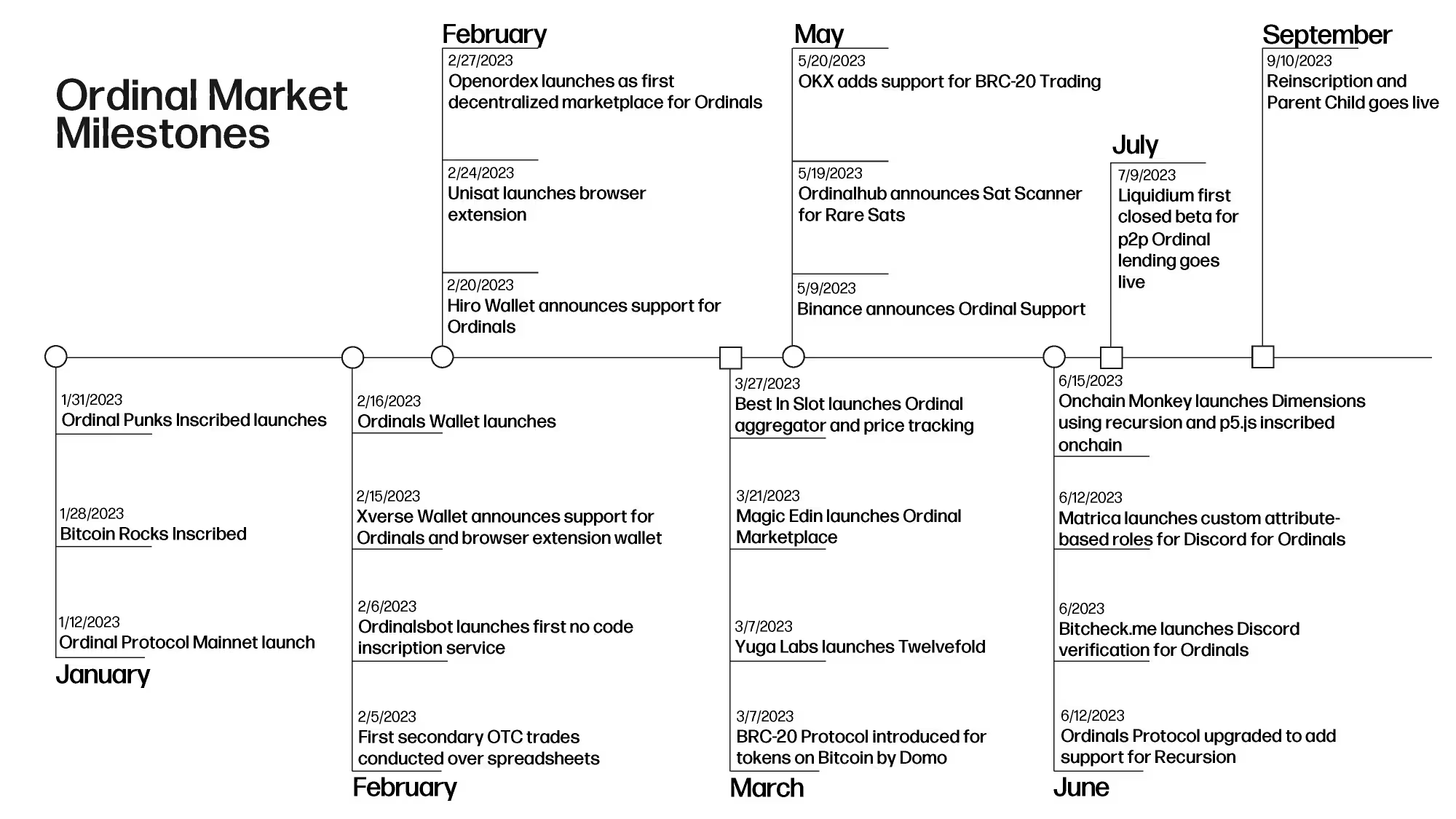
Although the market volume of Ordinals and NFTs has generally declined since the beginning of 2023, the development of Ordinals infrastructure continues to progress rapidly, indicating that Ordinals is not just a passing trend.
III. Ordinal Market Activities
The NFT minting activities on Ethereum began in August 2015 with the launch of the Terra Nullius NFT series. The first NFT minting on Polygon was recorded in May 2020, and the first minting on Solana was recorded in October 2020. NFT minting activities started on Ethereum, Solana, and Polygon before the summer of 2021, when NFTs gained mainstream media attention. Compared to the minting activities after the NFT boom in the summer of 2021, the minting activities in the first 200 days on these networks were relatively low. As a reference, when Solana and Polygon NFT activities first launched in 2020, the total market value of the entire NFT ecosystem was only $41 million. In just two years, by 2022, the NFT market value on all three blockchains had grown to $32 billion.
The following chart tracks the number of mintings that occurred on each blockchain in the first 200 days since their inception. The chart excludes mintings from the BRC-20 minting factory; the data below is based solely on image mintings.

The Ordinals ecosystem saw impressive user engagement in its initial 200 days of activity. During this period, 1.14 million digital artifacts were minted by Bitcoin users. Considering that Ordinals was launched during the bear market of cryptocurrencies, its rapid growth is noteworthy. In the first half of 2023, the number and minimum prices of blue-chip collectible NFTs declined rapidly. Despite the broader NFT market’s struggle to recover from the bear market, Ordinals has garnered significant attention, and the idea of Bitcoin digital artifacts is flourishing.
Although the minting activity of Bitcoin in the first 200 days was substantial, it still lags far behind the total minting activity on other mainstream blockchains, indicating that Ordinals has a long way to go in terms of adoption compared to the wider NFT ecosystem. One apparent reason for the significant difference in total minting volume across chains is that Ethereum, Solana, and Polygon have been supporting NFT activities for years. Additionally, with the help of the NFT boom cycle in 2021, Ethereum, Solana, and Polygon experienced accelerated adoption. If Ordinals continues to gain momentum in the next NFT bull market cycle, we may see Bitcoin start to compete with Ethereum, Solana, and Polygon in terms of total minting volume.
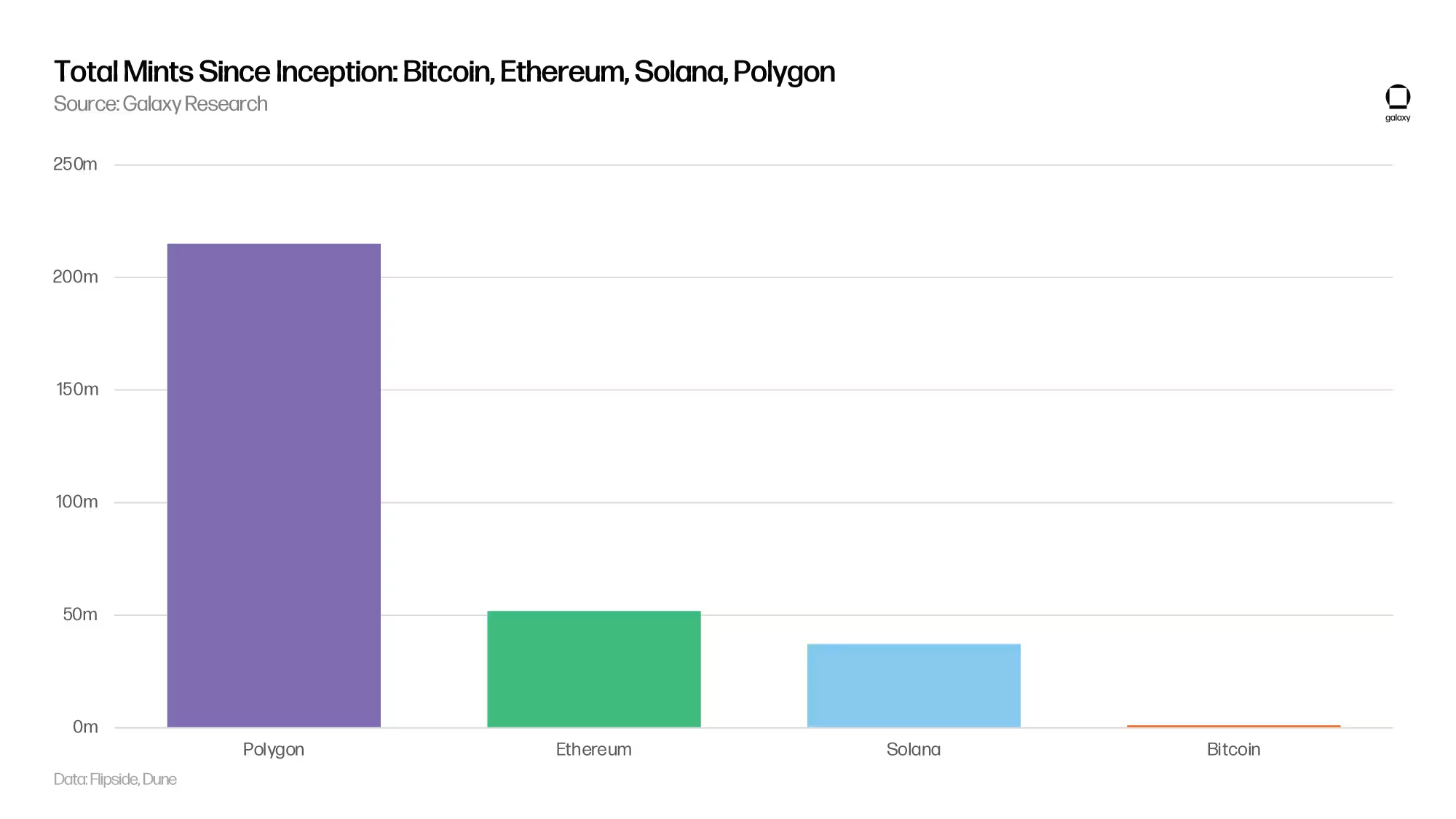
1) Transaction Activities
Although it is necessary to exclude non-image transactions from our metrics when compared to other NFT ecosystems, including all types of minting transactions is crucial for understanding the overall impact of emerging technologies. Ordinal transactions refer to all types of minting activities: images, texts, applications, audio, and other types of digital content. The advent of mintings allows for the construction of other meta-protocols, such as tokenization schemes, with BRC-20 being the most popular to date. BRC-20 transactions are entirely text-based mintings, and BRC-20 transactions significantly outweigh non-BRC-20 Ordinals transactions. By observing the transaction volume of the top 50 BRC-20 tokens, we find that most BRC-20 transactions have lower values. From January 1st to August 31st,

In order to better compare the Ordinals trading activities with the broader NFT trading activities, we tried to exclude BRC-20 from the detailed description of the Ordinals trading volume calculation in the next section of this report.
2) Rollup
In 2023, NFT trading volume dropped significantly. From February to August 2023, monthly NFT trading volume declined for six consecutive months. August 2023 was the worst-performing month for NFTs this year, with a trading volume of 500 million US dollars, a four-fold decrease from February 2023. Despite unfavorable market conditions for NFTs in 2023, Ordinals achieved meaningful growth. It is worth noting that Ordinals accounted for 18% of all NFT trading volume in May.
In the first three quarters of 2023, Ethereum dominated the NFT trading volume, surpassing the sum of Solana, Bitcoin, and Polygon. Although Ordinals had minimal trading volume in January 2023, Bitcoin accumulated the third highest network NFT trading volume, reaching 596 million US dollars. Even excluding BRC-20 from the total number of Bitcoin ordinal quantities, Bitcoin is still the third largest and most popular blockchain for digital collectibles after Ethereum and Solana.
(Note: To exclude the trading volume of BRC-20 from the calculations below, we subtract the cumulative trading volume of the top 50 BRC-20 tokens (187.5 million US dollars) from the total trading volume of Ordinals (596.4 million US dollars). The top 50 BRC-20 tokens account for the vast majority of the total trading volume of BRC-20.)

On May 11, 2023, the daily trading volume of Ordinals reached a historic high, when the first wave of BRC-20 tokens were minted through Unisat and the Ordinals wallet. From May 1, 2023, to July 18, 2023, the daily trading volume of Ordinals generated a total trading volume of approximately 207 million US dollars, with an average daily trading volume of over 2.5 million US dollars.
The following chart shows the daily trading volume of Ordinals converted from BRC-20 transactions from February to September 2023. To convert the trading volume data of BRC-20 transactions in the chart below, we eliminated the trading volume data from May 5 to December 12, 2023. During this period, Unisat generated sales of over 56 million US dollars solely through BRC-20. Due to the difficulty of accurately categorizing the volume of text-based inscriptions and other types of inscriptions from the market based on images, there may be instances of BRC-20 trading volume on other points in the market that we cannot eliminate except for Unisat.
The chart below also does not include off-market trading data from Ordinals and Twelvefold Mint, as these transactions do not exist in the market trading volume data tracked by Dune Analytics. The main sales volume of Yuga Labs TwelveFold Mint generated approximately 16.5 million US dollars of trading volume for Ordinals in a single day. In terms of image-based Ordinals trading volume, off-market transactions of Ordinals account for at least 10 BTC (about 270,000 US dollars). The chart represents our best estimate of the daily trading volume of Ordinals, excluding the frenzy of BRC-20.
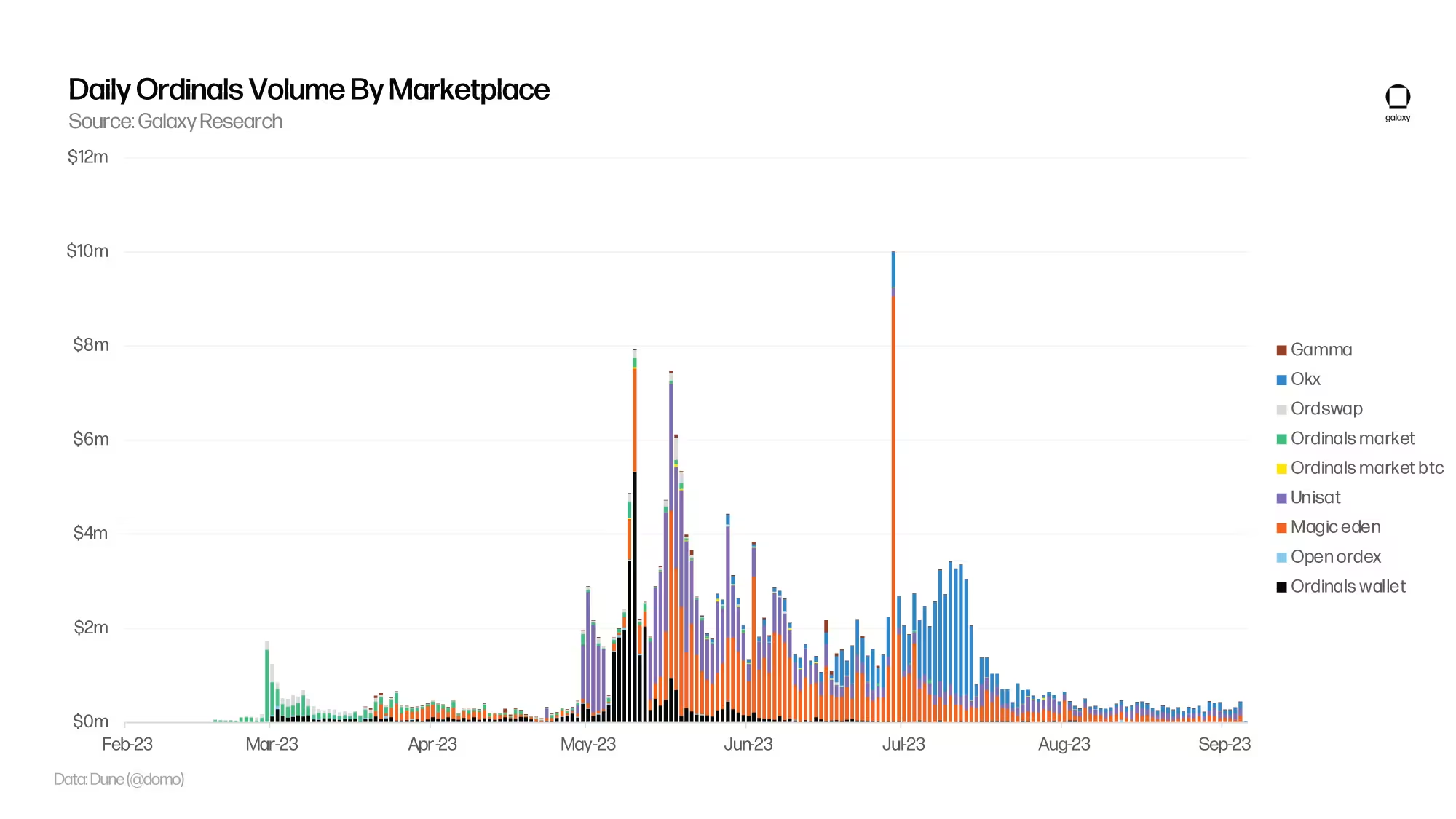
Before Ordinals gained significant support from major NFT markets, there were some early Ordinals trading markets. From February 2023 to April 2023, the Ordinals market, Ordinals wallet, and Ordswap dominated the Ordinals trading volume. However, when Magic Eden launched support for Ordinals in March 2023, the dominant position in market trading volume shifted from the early markets. Magic Eden’s entry into the Ordinals field shocked the market as they were the first major NFT market to support Ordinals on other chains.
When Magic Eden launched support for Ordinals, Magic Eden was the fifth largest NFT market by trading volume, with over 1.3 million users. In terms of Ordinals trading volume, the most significant markets are now Magic Eden, Unisat, and OKX, accounting for 28%, 28%, and 38% respectively.

Although Magic Eden and OKX started relatively late in the Ordinals ecosystem, they now account for 36% and 25% of the total Ordinals respectively.
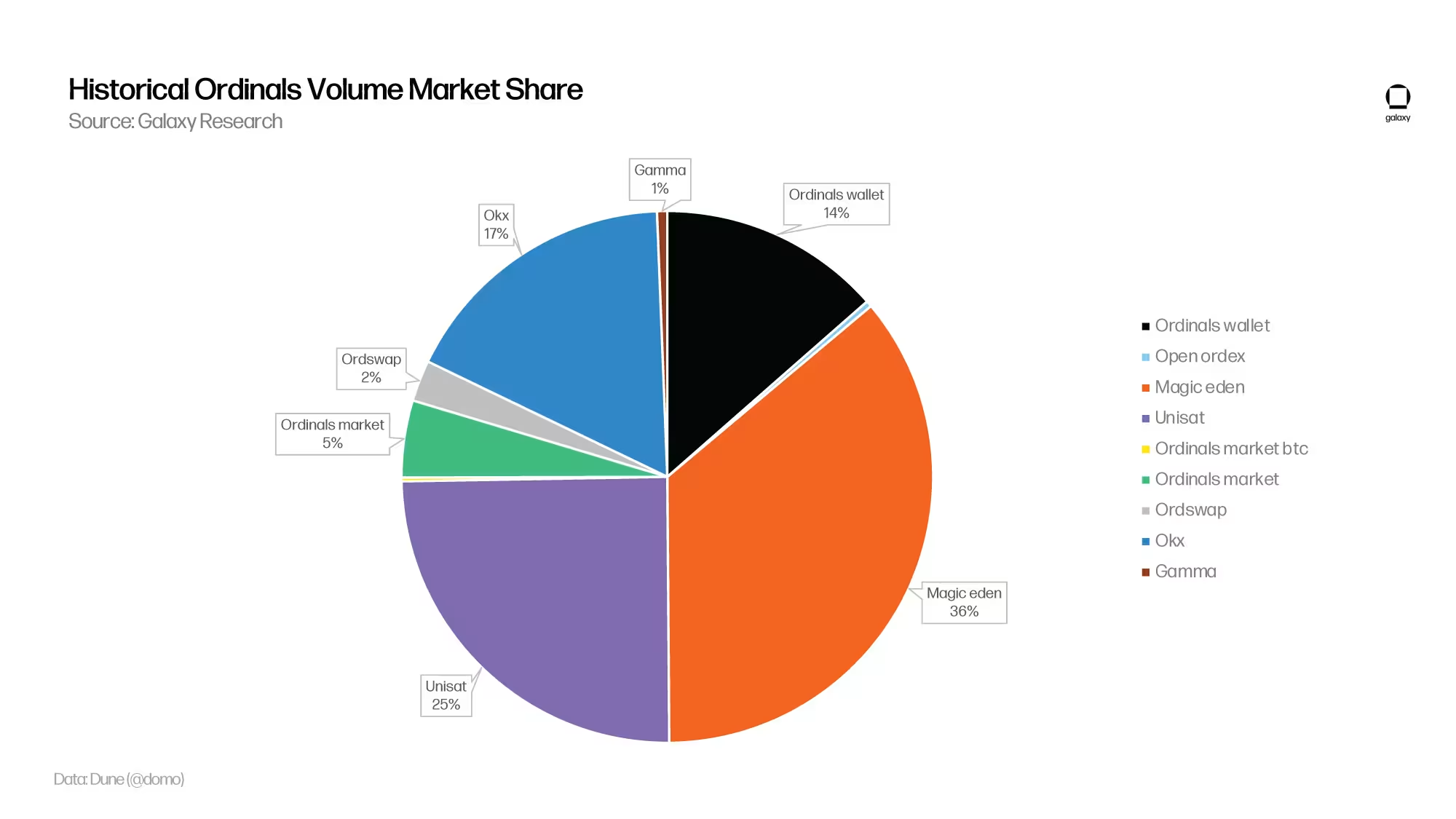 In the next section of the report, we analyze the impact of Ordinals trading activity on Bitcoin’s mempool and transaction fees.
In the next section of the report, we analyze the impact of Ordinals trading activity on Bitcoin’s mempool and transaction fees.
IV. The Impact of Ordinals on Bitcoin’s Mempool and Transaction Fees
In the first half of 2023, miners accumulated a total of 8,684 BTC in fees. It is worth noting that in the first half of 2023, 1,779 BTC of the transaction volume was related to inscriptions, accounting for 20% of the total miner revenue. In comparison, the fees in the first half of 2022 were 2,325 bitcoins, and the total fees for the whole of 2022 were 5,375 bitcoins.
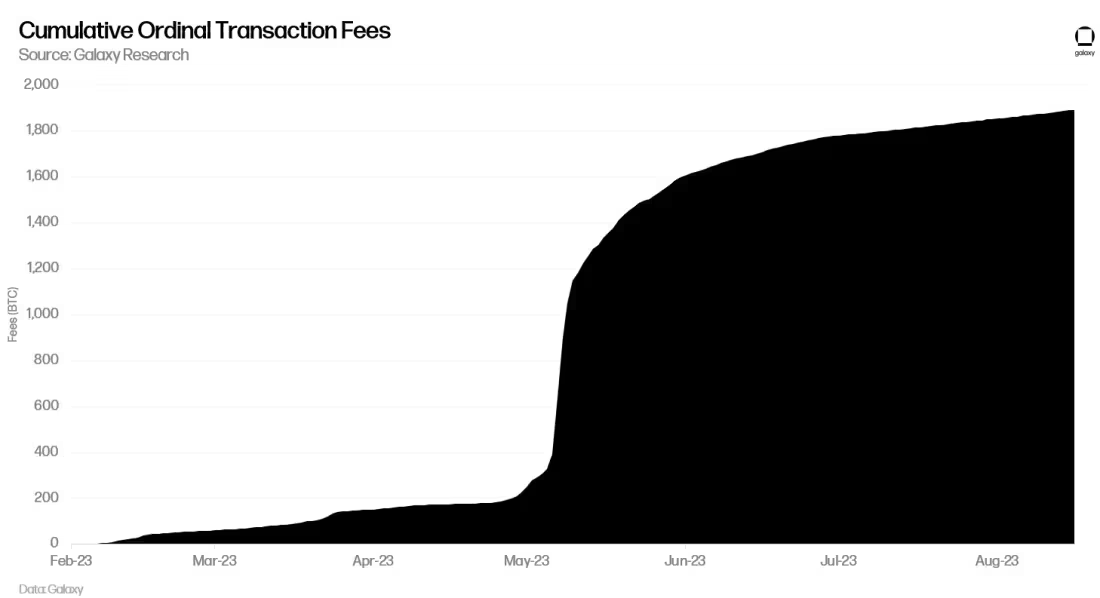
From May 2023 to July 2023, the share of ordinal-related transactions on Bitcoin relatively remained unchanged, decreasing from 47% of all Bitcoin transactions to 46%. During the same period, the share of Bitcoin transaction fees from Ordinals decreased from 30% to 12%.
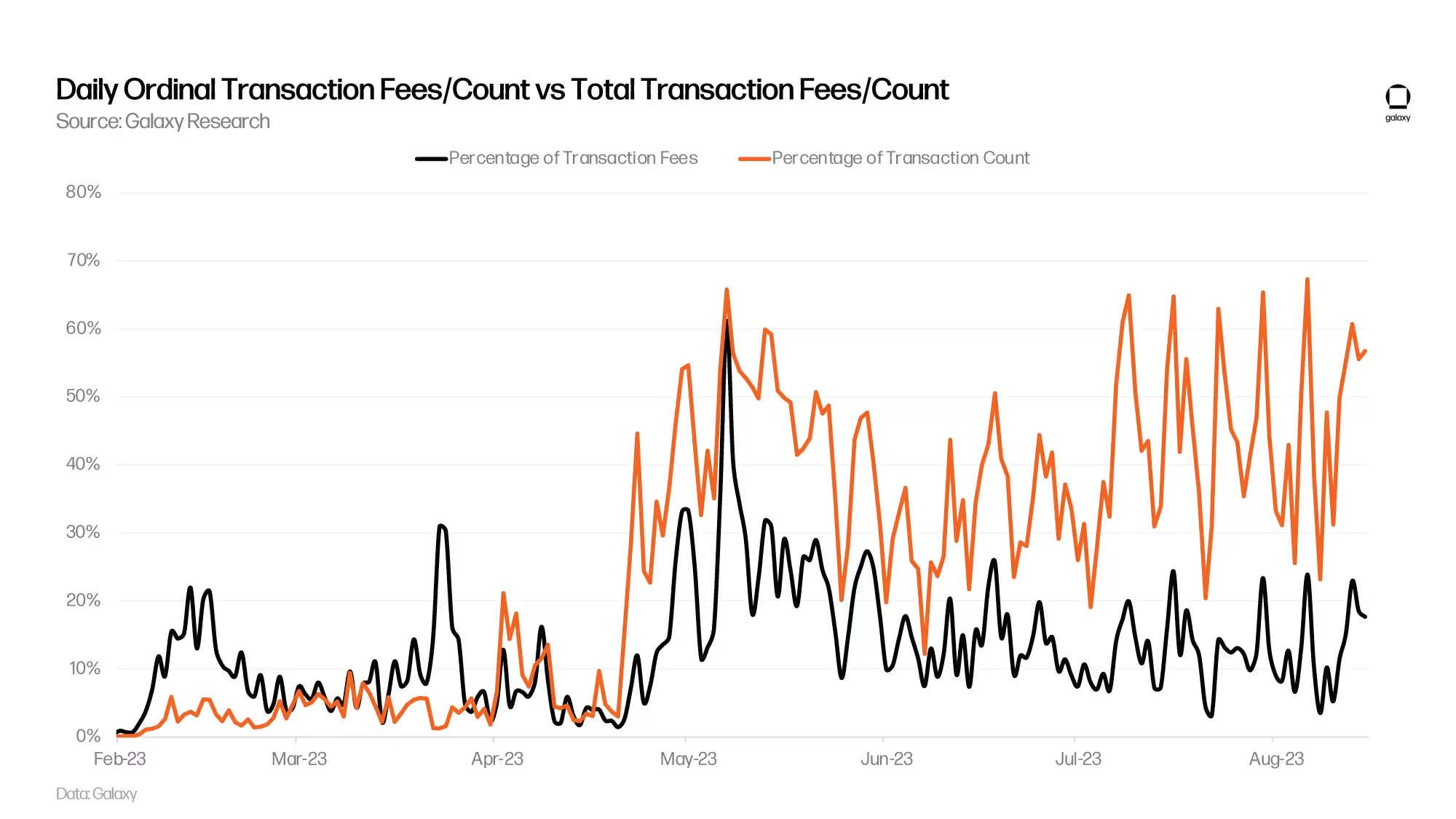
Aside from the transactions in May 2023 that led to a surge in fees, most transactions that had fees higher than the median fee rate in a block were not related to Ordinals. Although ordinals account for a large portion of the total transactions, they are not the most profitable transactions in a block.
While Ordinals may not be the most expensive transactions on Bitcoin, they have caused a backlog of transactions and congested the Bitcoin mempool (the pool of unprocessed Bitcoin transactions). The mempool has been backlogged since April 22, 2023, for about 4 months. This is the longest active state of an uncleared mempool since the surge in on-chain activity in early 2021.
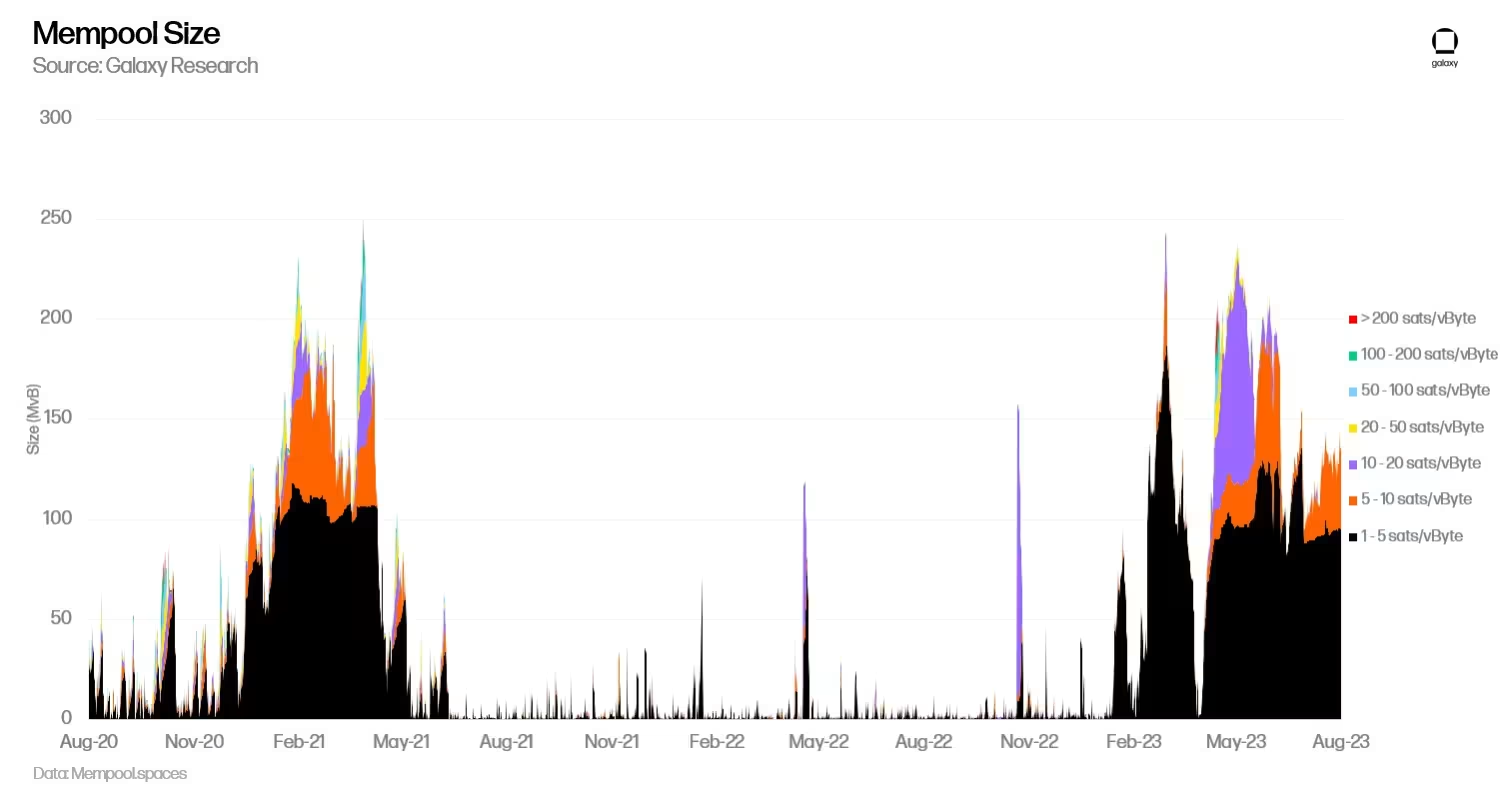
Whether someone pays the serial fee or conducts regular transactions to transfer Bitcoin from one address to another, Bitcoin users usually pay excessive fees for block space. In the next section of the report, we will analyze in detail the surge in transaction fees in the first half of 2023.
1) Factors driving the increase in Bitcoin fees
The two main factors causing the increase in Bitcoin fees are:
The time difference in block space consumption leads to voluntary overpayment. Block space consumers exhibit different time preferences, which means differences in urgency and strategic time decisions, resulting in different block space consumption patterns and driving fees up during peak demand.
Overpayment due to erroneous rate estimation rather than voluntary overpayment. Users may unintentionally pay a premium on the standard transaction fee due to calculation errors or a lack of understanding of the current fee structure.
The behavior of users with low time preference can be reasonably explained and visualized on-chain. These users always bid higher than the minimum possible fee level accepted by the mempool (the default mempool size is 300 MB, so when it reaches capacity, it starts clearing or removing transactions starting from the lowest fee rate). Anything above this “clearing level” can be considered a “time preference premium” as it indicates a desire to be included in a block faster than X, where X represents the entire mempool being cleared and the “clearing level” returning to zero sat/vByte.
However, high time preference users are optimizing for different trade-offs such as opportunity cost, and analyzing their behavior requires making subjective assumptions. Using this framework, we can start quantifying and concretizing the size of the “time preference premium” that users are willing to pay. In a sense, this “time preference premium” can often be seen as how much users are willing to “overpay” to be included in the next block (or multiple blocks). This will be described as voluntary overpayment (e.g., BRC-20 users trying to mint new tokens before reaching maximum supply). Some users may pay excessive fees due to other non-economic factors (e.g., poor fee estimation by wallets and trading platforms). These types of transactions will be described as involuntary overpayment.
Below is a case study illustrating an example of voluntary overpayment in Bitcoin.
2) DeGos Mint Case Study
The DeGods Mint in March 2023 serves as an illustrative case study to conceptualize why users would voluntarily overpay transaction fees. As background, DeGods is a collection of 10,000 NFTs initially launched on the Solana blockchain in 2021. In March 2023, the creators of DeGods introduced their NFT collection on Bitcoin. Prior to this, the creators of DeGods sold their collectibles through Discord giveaways. The DeGods Mint on Bitcoin sold on-chain on a first-come, first-served basis. Starting from block 781,279, the inscriptions were sold at a minting price of 0.333 BTC. Users who were able to include their transactions in the first 500 confirmed transactions before the mint were the lucky ones who could purchase the DeGod inscriptions at the minting price.
The DeGods inscription casting process has caused a frenzy among users, as many have had to speculate wildly on the appropriate fees attached to their transactions in order to succeed in casting. DeGod minters paid fees ranging from 7 to 1,725 US dollars for their transactions, as shown in the table below:
Other simple facts about the DeGod mint include:
During the minting process, the highest fee rate observed in the block was 39,177 sats/vByte, with a total transaction fee of 10,000,000 sats (0.1 BTC), which is 932 times higher than the median fee rate in the block.
The median fee rate for block 781,279 is 6 times higher than the median fee rate in the previous block.
The total fees for this block are 3.552 BTC or 96,000 US dollars. The block has confirmed a total of 2,602 transactions.
Out of the 2,602 transactions, 559 are related to the DeGod mint. The total fees for DeGod mint-related Bitcoin transactions are 2.969 BTC or 80,000 US dollars (accounting for 83.6% of the total fees).
The median fee rate paid by those attempting to mint DeGod is 784 sat/vByte, which is 18.6 times higher than the median fee rate for all transactions in the block.
From the perspective of the minters, determining how much fee to pay for a transaction is essentially a calculation of opportunity cost. If the minters believe they can profit from the mint immediately by selling the item, they will try to optimize the transaction by determining the selling price of the item on the secondary market and adding a certain fee to ensure a positive spread between the mint price and the secondary spread.
After the initial minting, the inscription of DeGod has a secondary market value of 1 BTC. Compared to other minters, those who paid more than 90% or more for DeGod can still profit from a secondary sale if they sell immediately after purchase, as shown in the table below:
The next section of this report will delve into the factors driving the rise in Bitcoin fees.
3) Quantifying the “Overpayment” of Bitcoin Transactions
Based on these characteristics, we can quantify the on-chain “overpayment” activity of users in casting and exchanging ordinals with regular Bitcoin transactions. The method is broken down step by step as follows:
For primary inscription transactions (i.e. Ordinals transactions), they are identified by the transaction IDs listed on Ordinals.com. All other transactions during the same period are classified as regular Bitcoin transactions. It is worth noting that some of these regular Bitcoin transactions may be secondary market transactions that were not captured on Ordinals.com. However, as shown by the NFT data aggregator CryptoSlam, the number of secondary sales has significantly decreased since the peak on May 8th, indicating that even if included, their impact on the fee rate may be minimal.
“Overpayment” is defined as the fee amount (in sats/vByte) of a transaction in a block that is higher than the median sats/vByte of the same block. We choose the median sats/vByte level of a block because we believe that bids around this level will provide a reasonable chance of being included in the next block for users with a high time preference.
Based on the above method, the following graph shows the average overpayment amount in bitcoin per day for the period from April 2023 to May 2023 for Ordinals and non-Ordinals users, when the block space market was dominated by users with higher time preference trying to participate in block space. BRC-20 frenzy.
Due to the continuous development of the mempool (and the block time is designed to be unstable, longer block time will increase the fee for a given block as users have more time to bid for the next block), rational users with high time preference will not bid when they see that the fee rate in the mempool is lower than the median fee rate of the mempool. For example, in the graph above, on May 9, 2023, Ordinals/BRC-20 users paid an average of 2.8 sats/vByte, higher than the median fee rate of the block, while non-ordinals users paid an average of 45.9 sats/vByte, which is 16 times higher than the median fee rate of the block.
Transaction-level data shows that during the period from April to May 2023, most of the fee pressure did not come from Ordinals/BRC-20 users, but from “regular” Bitcoin users. Contrary to popular belief, during the period of significant fee increases, blockchain regular users, who engage in so-called “financial transactions,” were largely responsible for pricing Ordinals transactions. In addition, the graph below shows that although Ordinals account for over 70% of the mempool transaction volume, they have never accounted for more than 30% of the total miner transaction fees.
The final insight about overpayments is that there is a significant difference between the average sats/vByte and the median sats/vByte during periods of high fee volatility. The graph below shows that both the average sats/vByte and the median sats/vByte reached their peak on May 8. Before May 8, the average sats/vByte and the median sats/vByte typically changed synchronously. However, after May 8, the percentage difference between the two sharply increased, reaching a peak of 116% (the average sats/vByte was 116% higher than the median sats/vByte). This difference may be due to overall fee volatility during the period of fee increases, which made fee estimation from wallets difficult during this period.

From a statistical perspective, the average value may be affected by outliers, which in this case are transactions with significantly higher fees. During periods of low volatility, the average fee and the median fee are similar, while during periods of high volatility, these two metrics show significant differences, further highlighting the impact of overpayments on fee dynamics. By measuring the convexity of Bitcoin fees, we know that very few transactions are the primary cause of on-chain fee increases.
As time goes by, the demand for Bitcoin block space continues to increase. Wallet providers will need to optimize their fee estimation schemes or provide solutions such as Replace-By-Fee (RBF) and fee selection to better serve users and prevent them from paying excessive fees for transactions. The overpayment of Bitcoin transactions can be mitigated through more sophisticated fee estimation services provided by wallets and trading platforms. Ordinary Bitcoin users will benefit from the fee estimation optimization and improvement pursued by wallets focusing on Ordinals, such as Xverse, Hiro, and Unisat. In particular, in the face of increased block space demand and resulting fee fluctuations, fee estimation schemes will become a key component of next-generation wallet technologies to prevent users from overpaying transaction fees.
4) Other insights and key points about Bitcoin fee dynamics
One surprising development that has caught market participants’ attention during the BRC-20 frenzy is how quickly fees skyrocket in periods of high demand in the mempool. This is because the driving force behind transaction fees is not the size of the mempool (i.e., the general demand for Bitcoin block space by low-time preference and high-time preference users), but rather the demand from entirely high-time preference users for inclusion in the immediately adjacent next block.
In the chart below, we illustrate this relationship by showing that fees typically do not skyrocket when the demand for the next block (in red) is less than or equal to the capacity of the next block. However, when the demand for the next block exceeds the capacity of the next block, fees rise. While this may seem obvious to casual mempool observers, it underscores an important assumption when discussing transaction fees on the network in the future. As long as the network can maintain demand levels for the next block below its natural capacity, the overall demand for block space is (almost) irrelevant.
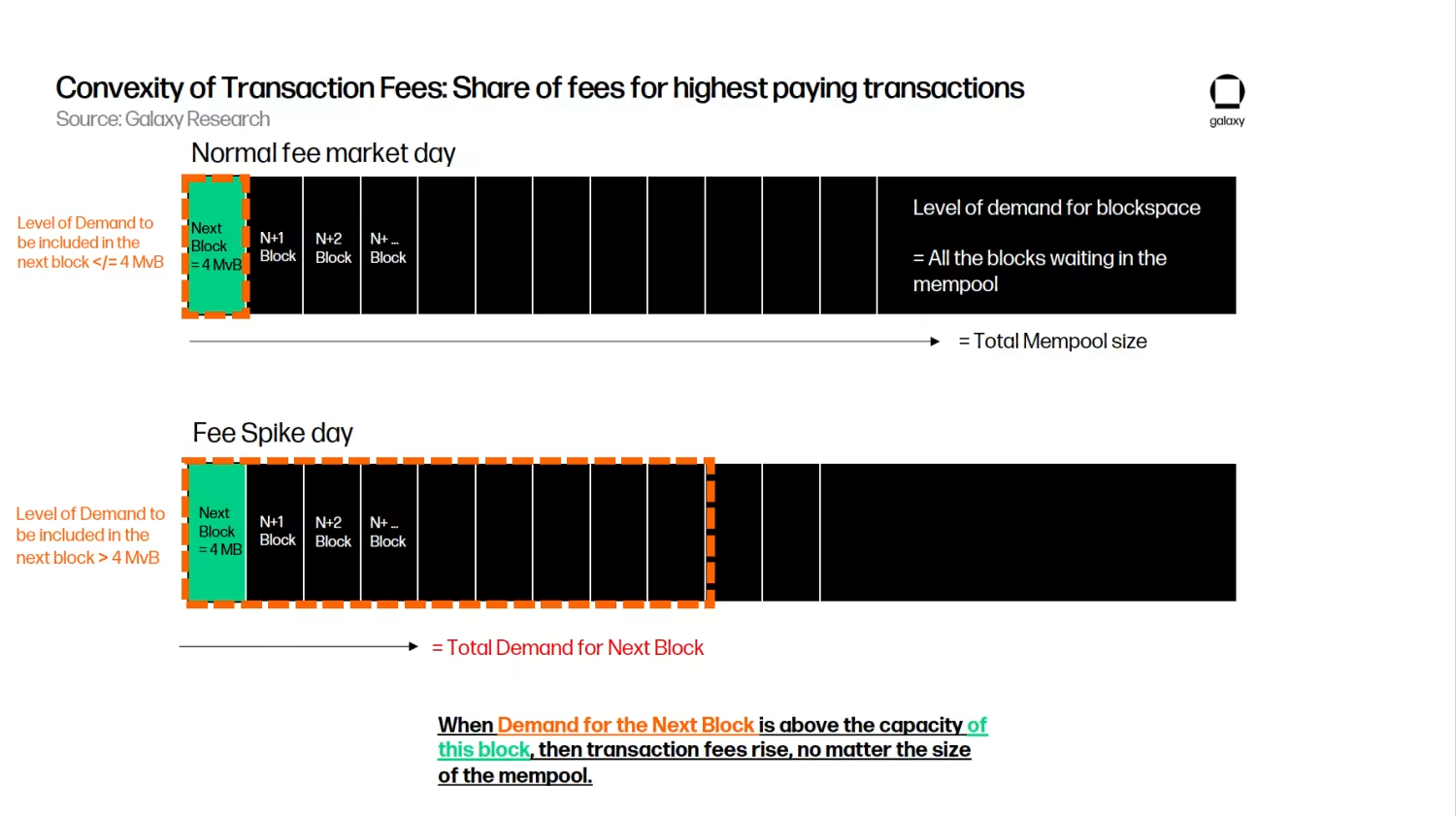
The framework used above for understanding block space demand is relevant to discussions of Bitcoin security budgets. The discussion should not focus on the question of “Will transaction fees rise enough to provide miners with sufficient income?” but rather on the question of “How do we ensure a continued demand for block space exceeding 4 MvB?”
When examining fee peaks during periods of high demand for the next block, we observe that a significant portion of the total fees paid in that block is driven by a small number of users paying extremely high fees, indicating strong convexity. However, this relationship becomes less apparent on days with lower fees. To illustrate the bidirectional dynamics of Bitcoin fees, the chart below shows that on May 15th, the top 2% of transactions accounted for over 15% of the total fees. On average, the top 10% of transactions account for 21.05% of the total fees in a block. However, the percentage of transactions from the top 2% of fees dropped significantly during the fee peak in May and then rebounded.
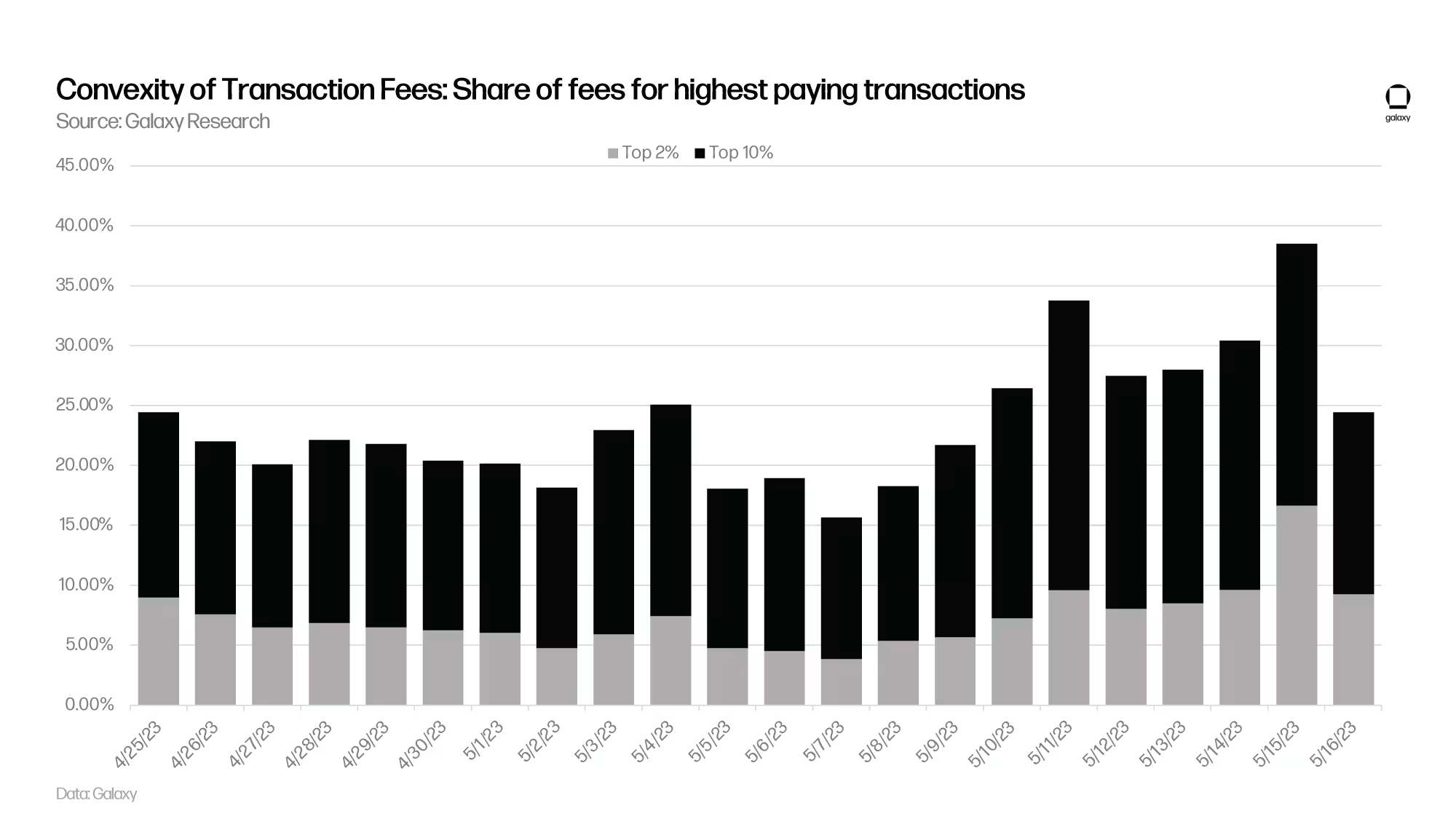
In normal circumstances, when Bitcoin fees are not skyrocketing, most of the fee pressure comes from abnormal transactions, which we define as the top 2% of transactions in a block calculated by sats/vByte fee. This is also reflected in the difference between the average sat/vBytes and the median sat/vBytes, which is likely due to involuntary overpayment or a lack of understanding of the mempool dynamics during fee fluctuations.
During peak fee periods, these outliers account for a smaller proportion of the overall fee pressure, indicating that while users are increasing the fees they are willing to include in the next block, they may not necessarily be paying excessively high fees compared to other users with high time preference. They are also bidding to be included in the same block.
In the next section of this report, we will delve into the new developments in Ordinals infrastructure and minting technology.
Five, New Developments in Ordinals
Bitcoin transactions, especially those involving ordinals, have greatly benefited from previous protocol-level upgrades (e.g., Segwit), which reduce the transaction weight and therefore lower the overall fees for these transactions. However, Segwit was not initially designed for Ordinals – neither was Taproot (the Bitcoin upgrade that made Ordinals creation possible). The presence and proliferation of ordinals on Bitcoin have become possible for unexpected reasons, but since their creation earlier this year, the Bitcoin development community is now working together to intentionally support such activities by building ordinals-centric tools. (For a more in-depth discussion of the factors that led to ordinals creation and their impact on Bitcoin’s development, see the report from March 2023.)
This section of the report will focus on the new technologies being developed on Bitcoin to facilitate the growth and maturation of the Ordinals market.
1) Recursion
In June 2023, major Ordinals block explorers were upgraded to enable recursive mementos and added support for JavaScript and CSS file types. Recursion allows users to link one memento to another using the following format: /content/. Through recursion, users can add JavaScript and CSS libraries to create rich HTML files directly on Bitcoin. One of the best examples of the benefits of recursion is provided by the OrdinalsBot team, which we will introduce below:
Example of a recursive memento

Source: OrdinalsBot
If you were to engrave each layer mentioned above into a single image, the file size would be 250 kb before any compression techniques are applied. Assuming a collection size of 10,000 pieces and an engraving fee of 10 sat/vbyte, the cost would be approximately $1.8 million.
Through recursion, HTML engravings can be created. By utilizing the HTML canvas element, engravers can use JavaScript to create graphics, as shown in the figure below:

HTML element used to create graphics using JavaScript, Source: OrdinalsBot
Then, recursion can be used to reference the written JavaScript logic, which can significantly reduce the use of block space and reduce the associated costs of generating the final image.
This process is operated through a comprehensive script that includes a single drawing function. This function takes a canvas element and a series of engravings links, coordinating the loading of all image layers.
Therefore, it facilitates seamless creation of the canvas, ensuring that only the complete image is rendered, rather than gradually loading individual layers, providing a simplified and cost-effective visualization process.

Final recursive engravings, Source: OrdinalsBot
The final result is a complete image that can be resized or saved like a regular image. Compared to 250,000 bytes, the final HTML engravings are only 621 bytes, but the image can still be viewed at full size or at a resolution of 250,000 bytes.
Assuming a collection size of 10,000 blocks, the recursive process can save 99.7% of the total size (6.21 MB vs 2.5 GB).
Assuming a fee rate of 10 sats/vByte, the total cost of engraving the collection is approximately $12,000, compared to $1.8 million if not engraved separately using recursion.
In summary, recursion can be used as a compression technique to allow for a wider range of collection sizes and reduce the cost of engraving. Through recursion, collections can record the features of generating or creating PFP collections as their own separate layers and use recursive calls to generate the file images. The other three main benefits of recursion include:
Creators can surpass the 4 MB block size limit. By using recursion, complex digital artifacts can be assembled, reflecting the process of piecing together a puzzle. Initially, the individual components (similar to puzzle pieces) are engraved separately. Subsequently, the final engravings integrate these different elements, synthesizing them into a cohesive and singular image, thus presenting a unified visual from segmented engravings.
Recursion enables composability, unlocking various use cases. One major benefit of the composability provided by recursion is the ability to perform on-chain art display processes. Onchain Monkey (OCM) Dimensions is the first series to be displayed on-chain. Another use case unlocked by recursion is the ability to perform open edition and limited edition printing. Gamma recently released “Prints” which they marked as a new version. Prints are achieved by using recursion, with artists engraving on a high-resolution original artwork, and then Gamma creates a package for creating digital versions. By directly embedding the print number into the digital asset, the version number of the print can also be viewed on any display. Other features include on-chain lotteries and the ability to utilize the code library of on-chain engravings. The Onchain Monkey team incorporates the p5.js and Three.js libraries, allowing them to create their own Dimensions digital artifact collections. Users are also starting to join more advanced libraries, such as react.js and Animate.css libraries.
Recursion makes it more feasible to create games directly on Bitcoin. Developers can write popular game libraries and create more complex on-chain 3D games by recursively referencing these libraries.
To some extent, enscription has the ability to transform Bitcoin block space into a global hard drive, and recursion effectively optimizes storage and data, making it cheaper and more composable, thus expanding the possibilities and design space. The marketplace and browser act as web browser clients, used to explore and experience content on the Bitcoin blockchain. As more and more people write code libraries into Bitcoin, these code libraries can be referenced, making it easier for all creators to build more immersive experiences and artworks. The Ordinals collector Jokie88 has launched a GitHub repository that tracks a list of all code libraries recorded so far. The list currently includes 40 different libraries that can be recursively referenced.
2) Re-enscription
Re-enscription allows users to engrave multiple pieces of data onto the same satoshi (the smallest unit of Bitcoin). To reassign a satoshi, users need to own that satoshi, so artists cannot reassign sats containing their artworks after they are sold. Re-enscription was launched in the Ord client version 0.9.0 released on September 11, 2023. It should be clarified that re-enscription does not affect the immutability of enscriptions. Re-enscription does not overwrite or delete previously engraved data on a satoshi, but creates an array of data. All data re-recorded on a satoshi appears in chronological order.
The five main benefits of re-enscription are:
- A single satoshi contains all recursive elements: Re-enscription combined with recursion allows individuals to engrave all recursive elements on the same satoshi to create larger and more complex digital artifacts.
- Version control technology: Re-enscription can be used for upgrading or version control of code libraries or other on-chain applications.
- Reduced risk of fungibility issues: While enscription has already minimized the risk of fungibility for Satoshis, re-enscription further reduces this risk as multiple assets can be stored on a single satoshi.
- New metadata and storytelling opportunities: Through re-enscription, artists can effectively create entire art galleries or series on a single satoshi. Artists can also use re-enscription to create dynamic or living artworks. For example, re-enscription can be used as a better way to engrave books, where each page can be engraved on a single satoshi and viewed in chronological order through a browser.
Re-enscription also provides a mechanism for performing proof of ownership. After purchasing an enscription, collectors can re-enscribe the text file with their own name and then sell it to a new owner to display the history of the art collector.
3) Progenitor Enscription
Progenitor enscription is a way to enhance the guarantee of the provenance of enscriptions. Provenance refers to the ownership history, creator, and creation time of an artwork. Determining provenance is crucial for verifying the authenticity of artworks. The authenticity of NFTs on Ethereum and other general-purpose blockchains is determined by accounts and smart contracts. Provenance is determined by the wallet address that deployed the issuing smart contract. However, Bitcoin does not use an account-based model, making the Ethereum-based provenance approach impractical.
The creator of Ordinals, Casey Roadamor, did not associate the source with a Bitcoin wallet address. This includes privacy considerations and lack of customization. Instead, he conceptualized the idea of a root inscription, which would serve as the avatar or logo for future works. The root inscription is the “parent” and the future inscriptions, or “children,” can be linked back to the parent. In practice, the root inscription’s SAT is used as the input for revealing the transaction. When the output created by the submitted transaction is spent, the inscription content will be displayed on the chain. This is called a display transaction. Through this origin style, a lineage tree is created as shown in the following figure:
Simple Design of Parent-Child Inscriptions

Source: Medium, Cypherpork
The pull request for the parent-child inscription standard was merged into the Ordinals client in September 2023 and is currently in operation.
4) Rare and Unique Satellites
Many collectors want to engrave their artwork on satellites that have a certain degree of rarity or uniqueness. Mining pools have also noticed people’s interest in “rare” SATs. The mining pools Luxor, F2Pool, and BN Pool account for about 50% of the total hash rate, and they are separating rare resources from the block rewards they receive. In the past few months, rare Bitcoin markets have also emerged, making it easier for speculators and artists to acquire and trade these Bitcoins. Some famous markets include Magisat, Danny Deezy’sSat Dispenser, and Lumisat. NFT markets and Ordinals explorers (such as Magic Eden and Ord.io) also embrace the popularity of the concept of rare SATs, allowing users to sort and filter inscriptions by rarity.
Here are some common examples of rare satellite groupings and methods:
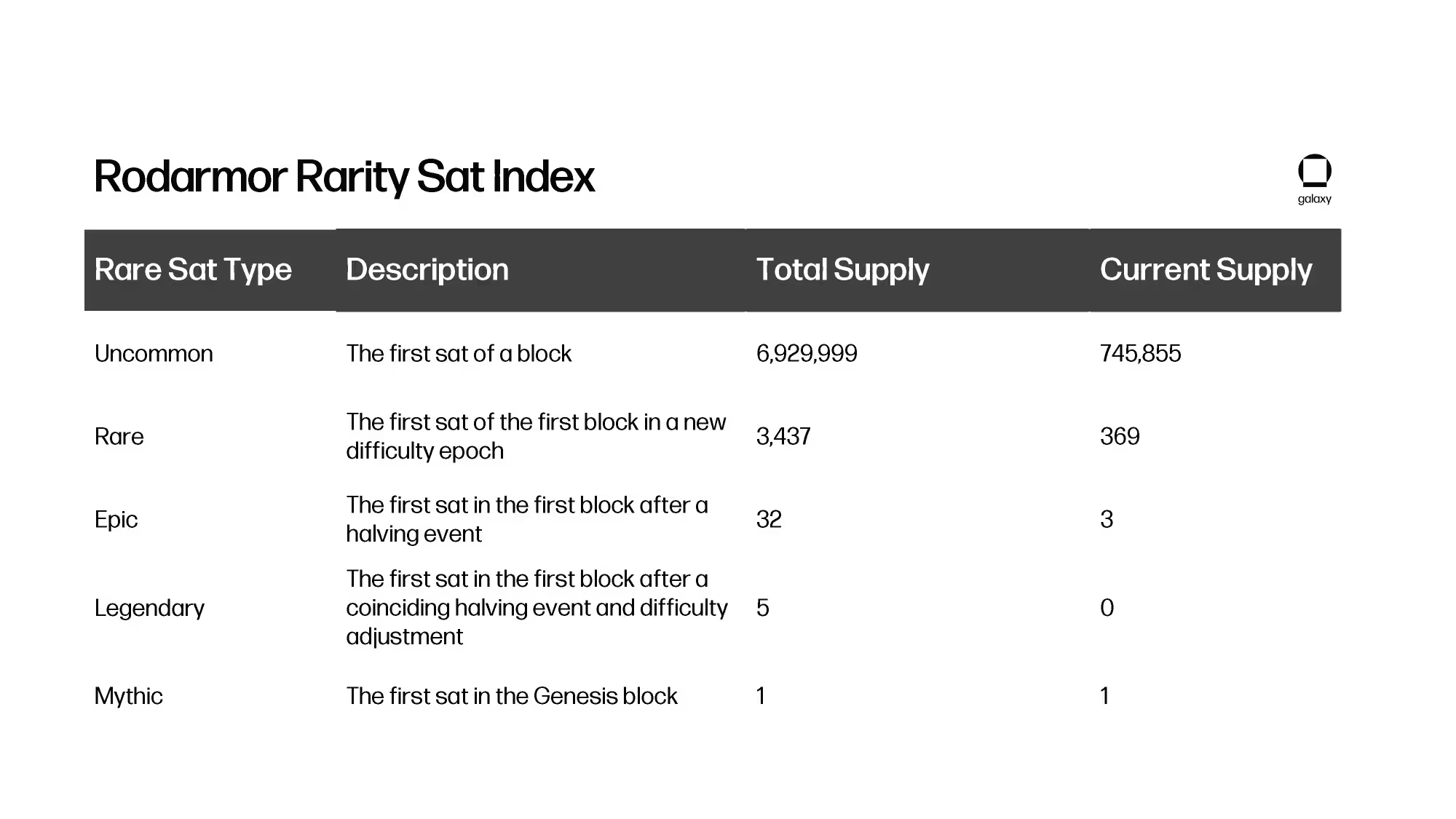
Rodamor Rarity Index. The Rodamor Rarity Index is a method developed by Casey Rodamor, the creator of the Ordinals client, to identify rare SATs.
Block 9 sat – Satoshi Sats. Block 9 sat is the oldest circulating sat, mined by Satoshi Nakamoto and sent to Hal Finney in the first-ever Bitcoin transaction. From a quantity perspective, the sats from the 9th block are not necessarily rare, as there are 50 billion satoshis in that block. It is currently unclear how many satoshis are still in circulation, as many complete Bitcoins in these early blocks are considered lost or dormant, locked away in wallets whose owners can no longer access their private keys. Due to its historical and cultural significance, the Block 9 satellite is highly sought after. Some popular series engraved on Block 9 Sats include Ordinal Maxi Biz (OMB) Green Eyes and Timechain Collectibles Series 2.
Block 78. Block 78 is the first Bitcoin block mined by someone other than Satoshi Nakamoto. Block 78 was mined by the famous cryptographer and advocate for digital privacy, Hal Finney. Similar to Block 9, in terms of quantity, Block 78 may not be rare because it has 50 billion satellites, and the circulating supply of these satellites is still unclear. These satellites are very popular due to their history and connection with Hal Finney. Some popular series engraved on Block 78 Sats include: OnchainMonkey (OCM) Dimensions and Ordinal Maxi Biz (OMB) Blue Eyes.
Black Sats. Black Sats follow the Rodamor Rarity Index but are not the first Satoshi in a block, rather the last Satoshi minted in a block. The idea of Black Sats was created by @blackxbtx.

LianGuailindrome Sats. LianGuailindrome Sats refer to satellites that can be read the same way forward and backward digitally. There are approximately 9 billion LianGuailindrome Sats, accounting for 0.0000043% of the total supply. Some popular collections engraved on LianGuailindrome Sats include: Geo Ordinals and LianGuailindromes.
Sat Names. There are several different representations of ordinals, such as integer notation, decimal notation, degree notation, percentile notation, and names. The most common representation is integer notation, which is allocated based on the order of mining by Satoshis. Recently, people have started to experiment and explore alternative representations of “Sat” names. Bitcoin developer and engraver Danny Deezy has launched his Satoshi Cards series, pushing the boundaries of Sat name elements. The Satoshi Cards are a collection of trading card-style artworks with human-readable words or phrases engraved on Sats.
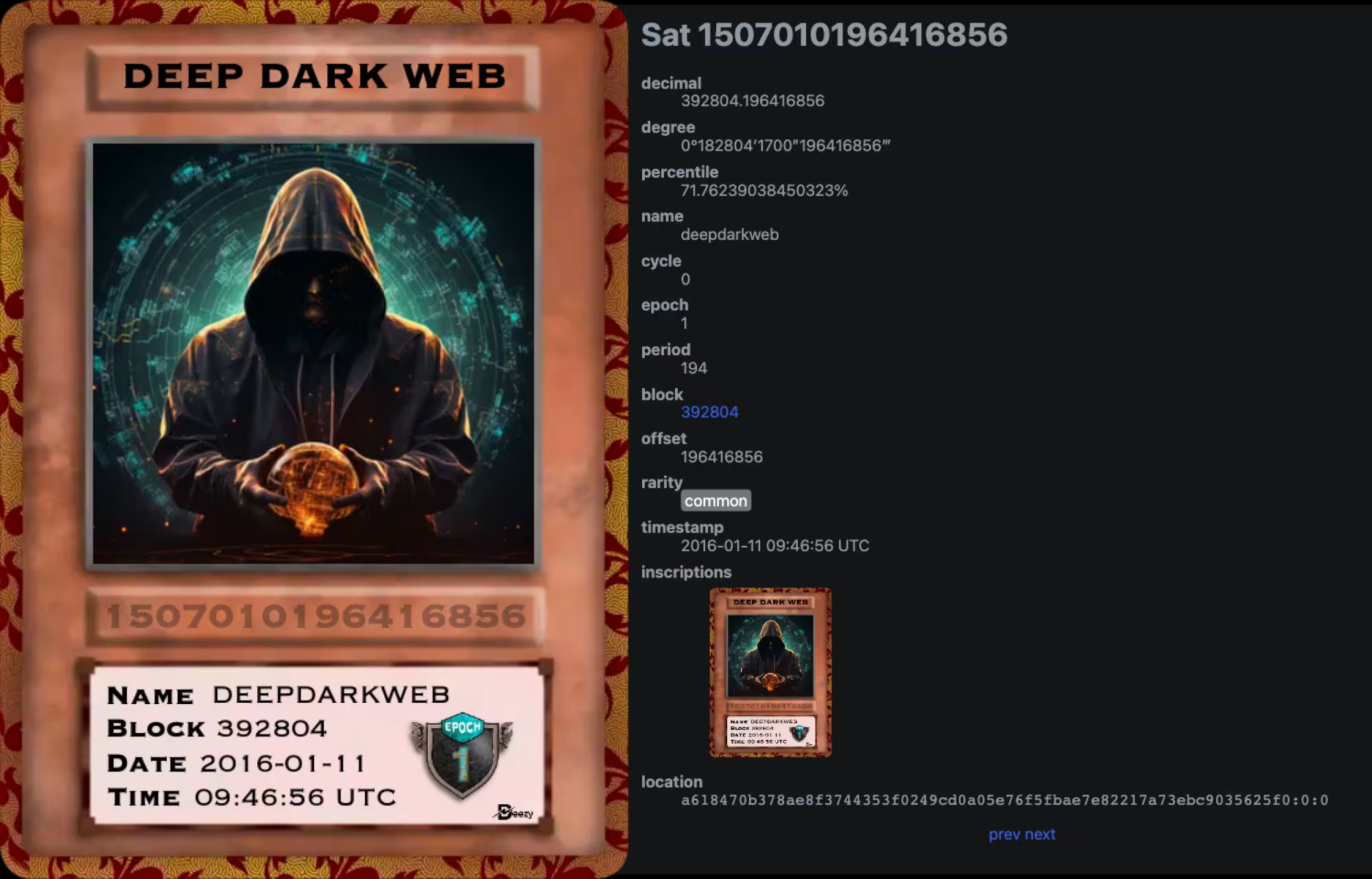
The Satoshi Card engraved with "deepdarkweb". Source: Ordinals.com
Conclusion
Bitcoin is one of the top three blockchains for NFT minting and trading activities, following Ethereum and Solana. By the end of 2023, the trading volume of Ordinals, including BRC-20, is expected to accumulate approximately $725 million. The adoption rate and value of Ordinals have continued to grow, supported by new developments and tools.
One of the most exciting innovations of Ordinals is recursive inscriptions, which provide NFT creators with a new framework to efficiently expand their digital collections. New collections and file types on Bitcoin may emerge from recursive inscriptions. In addition to recursion, techniques such as parent-child inscriptions are redefining how indices and proofs of ordinal origins are determined.
One of the reasons for the backlog of transactions in the memory pool is the ongoing Ordinals minting activity, which may exacerbate the volatility of transaction fees. This may be positive for miners, especially as the Bitcoin halving approaches, and may encourage crypto wallets and trading platforms to adopt more complex fee estimation strategies. Miners and mining pools are also embracing ordinals by collecting and selling rare satellites.
The Ordinals movement is driving Bitcoin into an unprecedented era of innovation, harnessing the untapped computational potential of the blockchain and giving rise to various new products. Looking ahead, the development path of Ordinals is not only full of hope, but the maturation of infrastructure and the upward trend in adoption rates also point the way for us. This sustained momentum confirms the notion that ordinals are not a fleeting trend but a permanent fixture in the realm of on-chain digital collectibles.
Like what you're reading? Subscribe to our top stories.
We will continue to update Gambling Chain; if you have any questions or suggestions, please contact us!